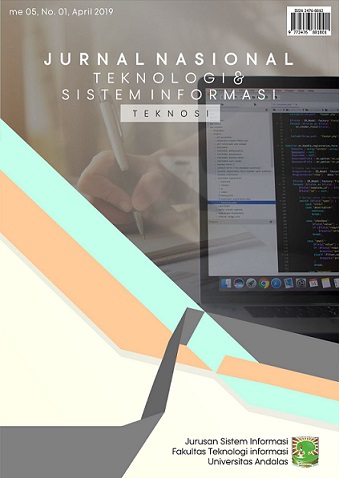Ekstraksi Basis Pengetahuan Ke Dalam Basisdata Graf Menggunakan Graf Property
DOI:
https://doi.org/10.25077/TEKNOSI.v5i1.2019.41-48Kata Kunci:
Basis pengetahuan, Graf, property, Yago, Neo4jAbstrak
Salah satu jenis commonsense knowledge adalah basis pengetahuan, yaitu kumpulan fakta dan informasi umum yang diketahui manusia. Basis pengetahuan yang tersedia sangat banyak, kami memilih Yago karena Yago menggabungkan beberapa sumber data menjadi sebuah ontologi. Fakta fakta ini saling terhubung sehingga representasi data graf adalah representasi data yang paling tepat untuk ini. Kita perlu melakukan ekstraksi basis pengetahuan kedalam basisdata graf supaya bisa digunakan untuk berbagai macam aplikasi lainnya. Tools basisdata graf Neo4j dipilih karena bisa melakukan penyimpanan dan pemrosesan graf dan bersifat opensource. Algoritma GPE digunakan untuk melakukan ekstraksi basis pengetahuan kedalam basisdata graf. Penelitian yang kami lakukan menghasilkan sebuah basisdata graf dengan jumlah node : 6.519.734 dan edge yang dihasilkan 18.724.395. Pengujian menggunakan query dengan berbagai permasalahan graf berhasil dilakukan dan memberikan hasil yang diharapkanReferensi
[1] I. Robinson, J. Webber, and E. Eifrem, Graph Databases, Second edi. O’Reilly Media, Inc., 1005 Gravenstein Highway North, Sebastopol, CA 95472., 2015. [2] Z. C. Khan et al., “An Analysis of Facebook’s Graph Search,†2014. [3] X. L. Dong et al., “Knowledge Vault : A Web-Scale Approach to Probabilistic Knowledge Fusion,†Proceedings of the 20th ACM SIGKDD international conference on Knowledge discovery and data mining - KDD ’14, pp. 601–610, 2014. [4] A. Welc et al., “Graph analysis: do we have to reinvent the wheel?,†First International Workshop on Graph Data Management Experiences and Systems, p. 7:1--7:6, 2013. [5] A. Kanavos, G. Drakopoulos, and A. Tsakalidis, “Graph Community Discovery Algorithms in Neo4j with a Regularization-based Evaluation Metric,†WEBIST 2017 - Proceedings of the 13th International Conference on Web Information Systems and Technologies, 2017. [6] S. Abiteboul, R. Hull, V. Vianu, and F. Databases, Foundations of databases, vol. 29, no. 11. United States of America: Addison-Wesley Publishing Company, 1995. [7] W. Fan and J.-P. Huai, “Querying Big Data: Bridging Theory and Practice,†Journal of Computer Science and Technology, vol. 29, no. 5, pp. 849–869, 2014. [8] S. Ramanujam, A. Gupta, L. Khan, S. Seida, and B. Thuraisingham, “R2D: Extracting Relational Structure from RDF Stores,†in 2009 IEEE/WIC/ACM International Joint Conference on Web Intelligence and Intelligent Agent Technology, 2009, pp. 361–366. [9] R. Angles, “A Comparison of Current Graph Database Models,†in 2012 IEEE 28th International Conference on Data Engineering Workshops, 2012, pp. 171–177. [10] F. M. Suchanek, G. Kasneci, and G. Weikum, “YAGO: A Large Ontology from Wikipedia and WordNet,†Web Semantics, vol. 6, no. 3, pp. 203–217, 2008. [11] F. M. Suchanek, G. Kasneci, and G. Weikum, “YAGO: A Core of Semantic Knowledge Unifying WordNet and Wikipedia,†in Proceedings of the 16th international conference on World Wide Web - WWW ’07, 2007, p. 697. [12] S. Auer, C. Bizer, G. Kobilarov, J. Lehmann, and Z. Ives, “DBpedia : A Nucleus for a Web of Open Data,†in ISWC’07/ASWC’07 Proceedings of the 6th international The semantic web and 2nd Asian conference on Asian semantic web conference, 2007, pp. 722–735. [13] Z. Pan and J. Heflin, “DLDB: Extending Relational Databases to Support Semantic Web Queries,†in Practical and Scalable Semantic Systems, 2003. [14] Vojtech Kolomicenko, M. Svoboda, and I. Holubová, “Experimental Comparison of Graph Databases,†2013. [15] S. Jouili and V. Vansteenberghe, “An empirical comparison of graph databases,†pp. 708–715, 2013. [16] Wahyudi, M. L. Khodra, A. S. Prihatmanto, and C. Machbub, “Knowledge-based graph compression using graph property on Yago,†in 2017 3rd International Conference on Science in Information Technology (ICSITech), 2017, pp. 127–131. [17] F. Mahdisoltani, J. Biega, and F. Suchanek, “YAGO3: A Knowledge Base from Multilingual Wikipedias,†in 7th Biennial Conference on Innovative Data Systems Research (CIDR 2015), 2015, pp. 177–185.
Unduhan
Telah diserahkan
Diterima
Diterbitkan
Cara Mengutip
Terbitan
Bagian
Lisensi
Hak cipta untuk artikel ini ditransfer ke Jurnal Nasional Teknologi dan Sistem Informasi (TEKNOSI) jika dan ketika artikel diterima untuk publikasi. Yang bertanda tangan di bawah ini dengan ini mentransfer setiap dan semua hak di dalam dan ke kertas termasuk tanpa batasan semua hak cipta untuk TEKNOSI. Yang bertanda tangan di bawah ini dengan ini menyatakan dan menjamin bahwa makalah tersebut asli dan bahwa ia adalah pembuat makalah, kecuali untuk bahan yang secara jelas diidentifikasi sebagai sumber aslinya, dengan pemberitahuan izin dari pemilik hak cipta jika diperlukan. Yang bertanda tangan di bawah ini menyatakan bahwa ia memiliki kekuatan dan wewenang untuk membuat dan melaksanakan penugasan ini.
Kami menyatakan bahwa:
- Makalah ini belum diterbitkan dalam bentuk yang sama di tempat lain.
- Makalah ini tidak akan dikirimkan di tempat lain untuk publikasi sebelum penerimaan/penolakan oleh Jurnal ini
- Izin hak cipta diperoleh untuk materi yang diterbitkan di tempat lain dan yang memerlukan izin ini untuk reproduksi.
Selanjutnya, Saya/kami dengan ini mentransfer hak publikasi yang tidak terbatas dari makalah yang disebutkan di atas secara keseluruhan kepada TEKNOSI. Transfer hak cipta mencakup hak untuk mereproduksi dan mendistribusikan artikel, termasuk cetak ulang, terjemahan, reproduksi foto, mikroform, bentuk elektronik (offline, online) atau reproduksi lain yang serupa.
Penulis yang sesuai menandatangani dan menerima tanggung jawab untuk merilis materi ini atas nama setiap dan semua penulis bersama. Perjanjian ini harus ditandatangani oleh setidaknya salah satu penulis yang telah memperoleh persetujuan dari rekan penulis jika berlaku. Setelah pengajuan perjanjian ini ditandatangani oleh penulis yang sesuai, perubahan kepengarangan atau dalam urutan penulis yang tercantum tidak akan diterima.
Hak / Syarat dan Ketentuan yang dipertahankan :
- Penulis memiliki semua hak kepemilikan dalam setiap proses, prosedur, atau artikel manufaktur yang dijelaskan dalam Karya ini.
- Penulis dapat mereproduksi atau mengotorisasi orang lain untuk mereproduksi karya ini atau karya turunannya untuk penggunaan pribadi penulis atau untuk penggunaan perusahaan, dengan ketentuan bahwa sumber dan menyatakan hak cipta dimiliki TEKNOSI, salinan tidak digunakan dengan cara apa pun yang menyiratkan pengesahan TEKNOSI atas suatu produk atau layanan dari pihak mana pun, dan salinannya sendiri tidak ditawarkan untuk dijual.
- Meskipun penulis diizinkan untuk menggunakan kembali semua atau sebagian dari karya ini dalam karya lain, ini tidak termasuk mengabulkan permintaan pihak ketiga untuk mencetak ulang, menerbitkan ulang, atau jenis penggunaan ulang lainnya.














